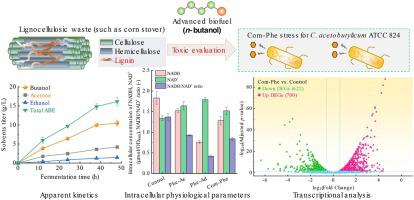Industrial Crops and Products ( IF 5.6 ) Pub Date : 2021-06-08 , DOI: 10.1016/j.indcrop.2021.113722 Hongzhen Luo , Zheng Liu , Fang Xie , Muhammad Bilal , Feng Peng

|
Lignocellulosic biomass is the most abundant bioresource to consider as an alternative feedstock to produce environmentally friendlier biobutanol as an advanced biofuel. However, the pretreatment for lignocellulose depolymerization suffers from toxic inhibitors formation and wastewater generation. The phenolic compounds, including phenolic aldehydes (Phe-Ad) and phenolic acids (Phe-Ac), derived from lignin degradation during the acid pretreatment of lignocellulose such as corn stover, are the main inhibitors for butanol fermentation. However, the overall impacts of the co-existence of Phe-Ad and Phe-Ac (Com-Phe) on solventogenic clostridia metabolism were not investigated thus far. Here, toxic effects of Com-Phe on butanol fermentation were firstly evaluated by analyzing apparent kinetics, reducing power, and reactive oxygen species (ROS). The lower intracellular reducing power level and higher ROS result in a 56.3 % decrease of butanol titer after 12 h stress. Subsequently, the response mechanism of Clostridium acetobutylicum to Com-Phe stress was elucidated by RNA-seq focusing on physiological processes with carbon metabolism and product biosynthesis. Some key genes related to heat shock proteins (HSP) and antioxidative activity were up-regulated under Com-Phe stress, which might be an adaptive mechanism of cells to alleviate its toxicity. Phenolics also altered two-component systems, sporulation, and cell division processes. This is the first report on systematic evaluation of the toxicity of Com-Phe on solventogenic clostridia. The proposed response mechanism provides valuable guidance (such as regulation of sugar transport, HSP-related genes, glutathione metabolism, etc.) for developing robust strains and promotes cleaner biobutanol production from lignocellulosic biomass.
中文翻译:

木质纤维素生物质对生物丁醇:木质素衍生酚酸和酚醛联合胁迫对丙酮丁醇梭菌的毒性作用和响应机制
木质纤维素生物质是最丰富的生物资源,可以考虑作为替代原料来生产更环保的生物丁醇作为先进的生物燃料。然而,木质纤维素解聚的预处理会产生有毒抑制剂和废水产生。酚类化合物,包括酚醛 (Phe-Ad) 和酚酸 (Phe-Ac),来源于木质纤维素(如玉米秸秆)的酸预处理过程中的木质素降解,是丁醇发酵的主要抑制剂。然而,迄今为止尚未研究 Phe-Ad 和 Phe-Ac (Com-Phe) 共存对产溶剂梭菌代谢的总体影响。在这里,首先通过分析表观动力学、还原能力和活性氧 (ROS) 来评估 Com-Phe 对丁醇发酵的毒性作用。较低的细胞内还原能力水平和较高的 ROS 导致丁醇滴度在 12 小时应激后下降 56.3%。随后,响应机制丙酮丁醇梭菌对 Com-Phe 胁迫通过 RNA-seq 阐明,重点关注碳代谢和产物生物合成的生理过程。一些与热休克蛋白(HSP)和抗氧化活性相关的关键基因在 Com-Phe 胁迫下上调,这可能是细胞减轻其毒性的一种适应性机制。酚类物质还改变了双组分系统、孢子形成和细胞分裂过程。这是关于 Com-Phe 对产溶剂梭菌的毒性的系统评价的第一份报告。所提出的响应机制为开发强大的菌株和促进从木质纤维素生物质中生产更清洁的生物丁醇提供了有价值的指导(如糖转运的调节、HSP 相关基因、谷胱甘肽代谢等)。











































 京公网安备 11010802027423号
京公网安备 11010802027423号